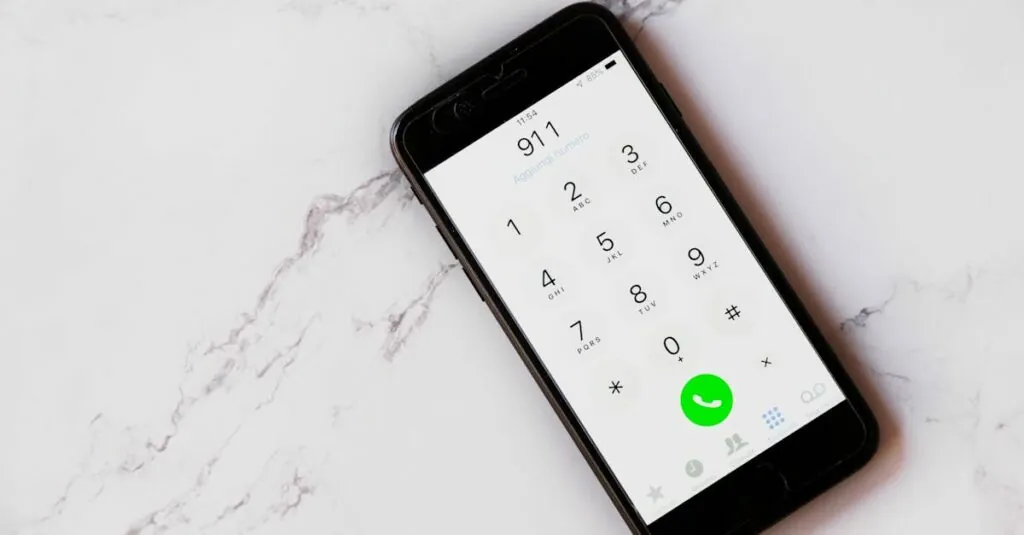Table of Contents
ToggleEver wondered why your iPhone buttons come in different shapes? It’s not just a design choice; it’s a clever way to enhance your user experience. From the sleek roundness of the volume buttons to the distinctive rectangle of the power button, each shape serves a purpose beyond aesthetics.
These button shapes aren’t just for show; they help users navigate their devices with ease. Imagine trying to find the right button in a dark room—those shapes are like little guiding stars! Understanding these shapes can make anyone feel like a tech wizard. So let’s dive into the world of iPhone button shapes and discover how they make life just a bit easier and a lot more fun.
Overview of Button Shapes on iPhone
Button shapes on the iPhone play a critical role in enhancing user experience. These designs provide both functionality and accessibility, particularly in various lighting conditions.
Importance of Button Design
Button design influences user interactions significantly. Round volume buttons permit quick adjustments, allowing for more intuitive control during phone calls or media playback. Meanwhile, the rectangular power button distinguishes itself by providing a clear target for users when their hands are in various orientations. Ergonomics also come into play; well-shaped buttons reduce finger strain and improve efficiency. Such thoughtful design choices cater to users’ needs, making devices easier to navigate.
Evolution of Button Shapes
Button shapes on the iPhone have evolved over several generations. Initially, older models featured more prominent physical buttons, enhancing tactile feedback during use. Recent models, however, lean toward minimalism with flatter, integrated button designs, promoting a sleek appearance. Changes in technology, like the introduction of touchscreens, have redefined button shapes, merging functionality with modern aesthetics. Each iteration reflects Apple’s commitment to innovation while maintaining practicality in design. Users continue to benefit from these advancements as smartphones become more integral to daily life.
Types of Button Shapes on iPhone
Different button shapes on the iPhone enhance functionality and improve user experience. These shapes vary between physical buttons and on-screen buttons, each serving unique purposes.
Physical Buttons
Physical buttons include the volume controls and the power button. Rounded shapes characterize volume buttons, providing quick access for adjustments. Users can easily find these buttons without looking, thanks to their tactile design. The power button, however, features a rectangular shape, ensuring clarity and precision during use. This distinct shape allows for easier identification, especially when multitasking in various orientations. Ergonomic considerations also play a role, as these shapes reduce finger strain during prolonged usage.
On-Screen Buttons
On-screen buttons primarily assist with navigation and control within apps. They adopt diverse shapes and sizes depending on their function, enhancing usability. Circular buttons often appear for quick actions, like play or pause, while square buttons may provide access to settings. Users benefit from intuitive designs that prioritize ease of interaction. The flexibility of these on-screen buttons allows for seamless integration with touch gestures, ensuring a cohesive user experience across different tasks. Shape and function work together to build a more accessible interface.
Functionality of Different Button Shapes
Button shapes on the iPhone don’t just enhance aesthetics; they serve crucial functional roles. Their designs improve user interactions and accessibility.
Volume Control
Volume control buttons feature a rounded shape, making them easy to identify and operate. Users enjoy quick adjustments to sound levels during calls or media playback. The distinct shape allows for intuitive navigation, even in low-light situations. Increased finger engagement is possible due to the ergonomic design that reduces strain. Users can adjust volume without distractions, contributing to a seamless experience.
Power and Sleep/Wake Button
The power and sleep/wake button has a rectangular shape, which stands out among other buttons. This shape provides a clear target for activation and deactivation of the device. Users can find it effortlessly, even in varying orientations. Pressing this button locks the screen or activates Siri, ensuring quick access to essential functions. Its design helps avoid accidental presses, enhancing usability. Overall, this button shape reinforces efficient device management.
User Experience and Accessibility
Button shapes on iPhones significantly influence user experience and accessibility. Recognizing this, Apple designs buttons with specific purposes that enhance functionality.
Impact of Button Shapes on Usability
Distinct button shapes directly impact usability. Rounded volume buttons facilitate rapid sound adjustments, making it easier for users to control audio while engaged in various activities. For example, an intuitive design allows quick access during conversations or media playback. Rectangular power buttons serve as a prominent target, streamlining actions like screen locking or activating Siri. Users can efficiently manage tasks without fumbling, ensuring a smooth interaction with their devices.
Accessibility Features
Accessibility features benefit greatly from well-designed button shapes. Users with limited dexterity find rounded and rectangular shapes easier to identify and use. For instance, visually impaired users rely on tactile feedback from these button designs, enhancing their navigational experience. Apple incorporates features such as VoiceOver, which reads information aloud when users engage with buttons, making interactions more accessible. Recognizing the need for diverse user accommodations, these design elements play a crucial role in ensuring technology remains inclusive for all.
Understanding the shapes of iPhone buttons reveals their crucial role in enhancing user experience. Each design choice is intentional and aimed at improving accessibility and functionality. The distinct shapes not only facilitate easy navigation but also contribute to overall device efficiency.
As iPhone technology continues to evolve the thoughtful design of buttons remains a hallmark of Apple’s commitment to user-centric innovation. With a focus on ergonomics and intuitive interaction users can appreciate how these features enhance daily smartphone use. The careful balance of form and function in button design ultimately makes technology more accessible and enjoyable for everyone.







